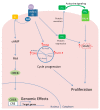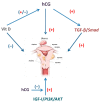Human Chorionic Gonadotrophin as a Possible Mediator of Leiomyoma Growth during Pregnancy: Molecular Mechanisms
- PMID: 28930160
- PMCID: PMC5618662
- DOI: 10.3390/ijms18092014
Human Chorionic Gonadotrophin as a Possible Mediator of Leiomyoma Growth during Pregnancy: Molecular Mechanisms
Abstract
Uterine fibroids are the most common gynecologic benign tumors. Studies supporting a strong pregnancy-related growth of leiomyomas generally claimed a crucial role of sex steroid hormones. However, sex steroids are unlikely the unique actors involved as estrogen and progesterone achieve a pick serum concentration in the last trimester while leiomyomas show a typical increase during the first trimester. Given the rapid exponential raise in serum human Chorionic Gonadotrophin (hCG) at the beginning of gestation, we conducted a review to assess the potential role of hCG in the striking growth of leiomyomas during initial pregnancy. Fibroid growth during initial pregnancy seems to correlate to the similar increase of serum hCG levels until 12 weeks of gestation. The presence of functional Luteinizing Hormone/human Chorionic Gonadotropin (LH/hCG) receptors was demonstrated on leiomyomas. In vitro treatment of leiomyoma cells with hCG determines an up to 500% increase in cell number after three days. Expression of cyclin E and cyclin-dependent kinase 1 was significantly increased in leiomyoma cells by hCG treatment. Moreover, upon binding to the receptor, hCG stimulates prolactin secretion in leiomyoma cells, promoting cell proliferation via the mitogen-activated protein kinase cascade. Fibroid enlargement during initial pregnancy may be regulated by serum hCG.
Keywords: estrogen; fibroid; human chorionic gonadotropin; leiomyoma; progesterone.
Conflict of interest statement
The authors declare no conflict of interest.
Figures



Similar articles
-
Comparison of uterine fibroids' growth pattern during pregnancy according to fetal sex: an observational study.Biol Sex Differ. 2019 Nov 27;10(1):53. doi: 10.1186/s13293-019-0266-2. Biol Sex Differ. 2019. PMID: 31775886 Free PMC article.
-
HCG promotes proliferation of uterine leiomyomal cells more strongly than that of myometrial smooth muscle cells in vitro.Mol Hum Reprod. 2000 Jun;6(6):523-8. doi: 10.1093/molehr/6.6.523. Mol Hum Reprod. 2000. PMID: 10825369
-
Pituitary gonadotrophin secretion during the first weeks of pregnancy.Acta Endocrinol (Copenh). 1977 May;85(1):177-88. doi: 10.1530/acta.0.0850177. Acta Endocrinol (Copenh). 1977. PMID: 324219
-
Receptor tyrosine kinases and their hormonal regulation in uterine leiomyoma.Semin Reprod Med. 2010 May;28(3):250-9. doi: 10.1055/s-0030-1251482. Epub 2010 Apr 22. Semin Reprod Med. 2010. PMID: 20414848 Free PMC article. Review.
-
Hormones and pathogenesis of uterine fibroids.Best Pract Res Clin Obstet Gynaecol. 2016 Jul;34:13-24. doi: 10.1016/j.bpobgyn.2015.11.015. Epub 2015 Nov 25. Best Pract Res Clin Obstet Gynaecol. 2016. PMID: 26725037 Review.
Cited by
-
Cotyledonoid dissecting leiomyoma of the uterus: a case report and review of the literature.J Med Case Rep. 2023 Dec 16;17(1):516. doi: 10.1186/s13256-023-04271-8. J Med Case Rep. 2023. PMID: 38102631 Free PMC article. Review.
-
Impact of Genetic Variants in Estrogen Receptor-β Gene in the Etiology of Uterine Leiomyomas.J Reprod Infertil. 2019 Jul-Sep;20(3):151-160. J Reprod Infertil. 2019. PMID: 31423418 Free PMC article.
-
Human Chorionic Gonadotropin (hCG)-An Endocrine, Regulator of Gestation and Cancer.Int J Mol Sci. 2018 May 17;19(5):1502. doi: 10.3390/ijms19051502. Int J Mol Sci. 2018. PMID: 29772831 Free PMC article.
-
Pregnancy and Cancer: Cellular Biology and Mechanisms Affecting the Placenta.Cancers (Basel). 2021 Apr 1;13(7):1667. doi: 10.3390/cancers13071667. Cancers (Basel). 2021. PMID: 33916290 Free PMC article. Review.
-
Expanded Somatic Mutation Spectrum of MED12 Gene in Uterine Leiomyomas of Saudi Arabian Women.Front Genet. 2018 Dec 14;9:552. doi: 10.3389/fgene.2018.00552. eCollection 2018. Front Genet. 2018. PMID: 30619444 Free PMC article.
References
Publication types
MeSH terms
Substances
LinkOut - more resources
Full Text Sources
Other Literature Sources
Medical

